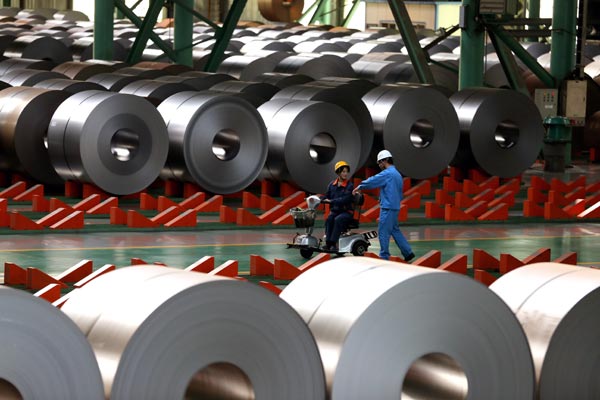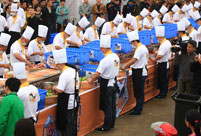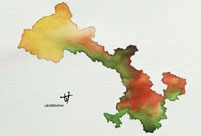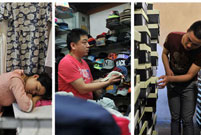 First Russian Street in Tianjin open to public
First Russian Street in Tianjin open to public
 Motorcycle stunt on the Bund
Motorcycle stunt on the Bund
 French Spiderman Alain Robert climbs up Galaxy Hotel in Macao
French Spiderman Alain Robert climbs up Galaxy Hotel in Macao
 Africans in Guangzhou
Africans in Guangzhou
 Pole dancer shows strength and beauty up in the air
Pole dancer shows strength and beauty up in the air
 College girls call for protection of ecological space on earth
College girls call for protection of ecological space on earth
 Top 10 celebrities driving auto brands
Top 10 celebrities driving auto brands
 10 low-carbon tips to save money
10 low-carbon tips to save money
 Luxury cars make Asia premiere at Auto China
Luxury cars make Asia premiere at Auto China
 Versatile dog
Versatile dog
 |
| A steel warehouse of Shougang Group in Caofeidian, Hebei province. Severe overcapacity brought a 2.33 billion yuan ($377 million)loss for major domestic iron and steel companies in the first quarter of this year.(China Daily) |
China's steel industry faces rising costs, shrinking demand and tight loans from banks. Those conditions made the sector's first quarter its toughest this century.
Weaker demand slowed growth in China's economy, the world's second-largest. Crude steel output increased in the first three months of this year, up 2.37 percent year-on-year, to 202.7 million metric tons, the China Iron and Steel Association said on Monday. That translates to daily output of 2.25 million tons and an annualized 822 million tons for 2014.
Severe overcapacity brought a 2.33 billion yuan ($377 million) loss for major domestic steel companies in the period, said Zhang Changfu, vice-chairman of CISA. It compares with a 3.3 billion yuan profit in the year-ago period.
Zhang cited high iron ore costs, rising spending on carbon emissions and falling prices for the result and said industry profitability is expected to improve, but still struggle, in the second quarter.
The domestic price of unit steel products dropped 10.14 percent, or 368 yuan a ton in the January-March period, according to data from the association.
The average price of export steel products was $794 a ton, down $63 year-on-year. Weak demand and increased output produced high steel inventories, which by end-March stood at 19.41 million tons, up 43.65 percent from the start of the year.
"China's steel industry needs structural adjustment, which takes time - from three to five years," Zhang said.
Li Xinchuang, head of the China Metallurgical Industry Planning and Research Institute, told China Daily that in the circumstances, no new steel capacity should be added for any reason.
"Existing steel capacity, which cannot meet the country's emission standards, should be eliminated," Li said.
Still, fixed steel-sector investment during the first quarter was 89.3 billion yuan, of which 71.6 billion yuan came from the private sector.
"The extremely low profitability is a warning bell for every steel company," said Zhang Lin, a senior researcher at the Lange Steel Information Research Center. "If they don't plan strategically for the long term and get prepared, they will die out."
Some iron and steel companies are working on non-steel business to improve their financial performance, potentially harming the steel industry's competitiveness and technological development, Lin said.
With the contribution from non-steel businesses stripped out, domestic steel companies' losses were 4.1 billion yuan in the first quarter, she said.
Some large companies, including Baosteel Group Corp and Tangshan Iron and Steel Group Co Ltd, plan to raise their non-steel business to 50 percent of their portfolio to survive. It's generally believed that non-steel business should account for around 30 percent, Zhang said.
 Overseas returnees strive for dreams in Beijing
Overseas returnees strive for dreams in Beijing Fried up: Chili pork bonanza in Central China
Fried up: Chili pork bonanza in Central China Hand-painted maps go viral online
Hand-painted maps go viral online 4th Beijing Int'l Film Festival ends
4th Beijing Int'l Film Festival ends Commando elite specializes in sign language
Commando elite specializes in sign language Man photoshops himself into girlfriend's childhood photos
Man photoshops himself into girlfriend's childhood photos Photo story: Stallholders at Beijing Zoo Wholesale Market
Photo story: Stallholders at Beijing Zoo Wholesale Market Artists on backstage
Artists on backstage Beckham launches fund to support youth soccer in China
Beckham launches fund to support youth soccer in China 'African Street' in Guangzhou
'African Street' in Guangzhou Special operation members in comprehensive training
Special operation members in comprehensive training Cute Shaolin boy melts the hearts of millions
Cute Shaolin boy melts the hearts of millions Giant panda Sijia is back to happy life
Giant panda Sijia is back to happy life Richest Chinese of 2014: half from the mainland
Richest Chinese of 2014: half from the mainland Chengdu - laid-back lifestyle makes happiest city
Chengdu - laid-back lifestyle makes happiest cityDay|Week|Month